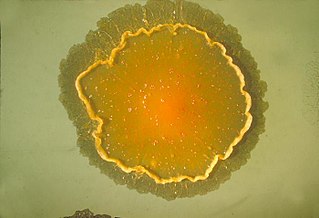Related Research Articles

Pseudomonadota is a major phylum of Gram-negative bacteria. The renaming of several prokaryote phyla in 2021, including Pseudomonadota, remains controversial among microbiologists, many of whom continue to use the earlier name Proteobacteria, of long standing in the literature. The phylum Proteobacteria includes a wide variety of pathogenic genera, such as Escherichia, Salmonella, Vibrio, Yersinia, Legionella, and many others. Others are free-living (non-parasitic) and include many of the bacteria responsible for nitrogen fixation.

The Hyphomicrobiales are an order of Gram-negative Alphaproteobacteria.
A chemotroph is an organism that obtains energy by the oxidation of electron donors in their environments. These molecules can be organic (chemoorganotrophs) or inorganic (chemolithotrophs). The chemotroph designation is in contrast to phototrophs, which use photons. Chemotrophs can be either autotrophic or heterotrophic. Chemotrophs can be found in areas where electron donors are present in high concentration, for instance around hydrothermal vents.

Mycobacterium marinum is a slow growing mycobacterium (SGM) belonging to the genus Mycobacterium and the phylum Actinobacteria. The strain marinum was first identified by Aronson in 1926 and it is observed as a pathogenic mycobacterium. For example, tuberculosis-like infections in fish (mycobacteriosis) and skin lesions in humans.
Robert Stanley Breed was an American biologist, born in Brooklyn, Pennsylvania. He received a bachelor's degree from Amherst College in 1898, an M.S. from the University of Colorado in 1899, and a Ph.D. from Harvard in 1902. In 1902 he became professor of biology at Allegheny College and was there secretary of the faculty in 1907–1910. He became known especially for his researches on the post-embryonic development of insects and for his contributions to scientific journals on the public milk supply. In 1903 he published The Changes which Occur in the Muscles of a Beetle during Metamorphosis.

Methanosarcinales is an order of archaeans in the class Methanomicrobia.
Aminobacter aminovorans is a Gram-negative soil bacteria.
In taxonomy, Methanotorris is a genus of the Methanocaldococcaceae. The organisms in this genus differ from those of Methanothermococcus in that they are hyperthermophiles and from those of Methanocaldococcus in that they have no flagella, are not motile, and do not require selenium to grow. These microbes have not been shown to cause any illnesses.
The International Journal of Systematic and Evolutionary Microbiology is a peer-reviewed scientific journal covering research in the field of microbial systematics that was established in 1951. Its scope covers the taxonomy, nomenclature, identification, characterisation, culture preservation, phylogeny, evolution, and biodiversity of all microorganisms, including prokaryotes, yeasts and yeast-like organisms, protozoa and algae. The journal is currently published monthly by the Microbiology Society.
Bergey's Manual of Systematic Bacteriology is the main resource for determining the identity of prokaryotic organisms, emphasizing bacterial species, using every characterizing aspect.
Bergey may refer to:
Virgibacillus chiguensis is a bacterium. It is Gram-positive, rod-shaped, motile, endospore-forming and halophilic, with NTU-101T as the type strain.

Sara Elizabeth Branham Matthews (1888–1962) was an American microbiologist and physician best known for her research into the isolation and treatment of Neisseria meningitidis, a causative organism of meningitis.
Rhodomicrobium is a microaerobic to anaerobic, purple non-sulfur, cluster-building genus of bacteria. Rhodomicrobium uses bacteriochlorophyll a and bacteriochlorophyll b for photosynthesis and occurs in fresh- and sea-water and in soil
Streptomyces sulfonofaciens is a bacterium species from the genus of Streptomyces which has been isolated from soil in Nachikatsuura from the Wakayama Prefecture in Japan. Streptomyces sulfonofaciens produces the antibiotic pluracidomycin.

Harold Joel Conn was an American agricultural bacteriologist, known for his work on soil microbiology and bacterial staining techniques. He was one of the founders of the Biological Stain Commission and also founded their journal, Stain Technology. He served as president of the Society of American Bacteriologists in 1948.

Leasure K. Darbaker was a bacteriologist and Professor of Pharmacognosy and Bacteriology at the Pittsburgh College of Pharmacy in Pittsburgh, Pennsylvania.
Robert George Everitt Murray was an English-Canadian bacteriologist. He is known for his research on bacterial structure and pathology, as well as bacterial taxonomy.
Wayne William Umbreit was an American bacteriologist.
References
- ↑ Bucher, Carl J.; Morton, Harry E. (1937). "David Hendricks Bergey". Science. 86 (2232): 320–321. Bibcode:1937Sci....86..320B. doi:10.1126/science.86.2232.320. p. 321
- ↑ Breed, Robert S. (1938). "David Hendricks Bergey 1860-1937". Journal of Bacteriology. 35 (4): i2-345. doi:10.1128/jb.35.4.i2-345.1938. PMC 545285 . PMID 16560118.
- ↑ Bergey, David Hendricks (1914). The Principles of Hygiene (5th ed.).
- ↑ Bergey's Manual of Systematic Bacteriology. By David R. Boone, Richard W. Castenholz, Don J. Brenner, George M. Garrity, Noel R. Krieg, James T. Staley. Springer, 2005. 2 vols. ( ISBN 9780387241456)
- ↑ Bergey's Manual Trust.
- ↑ "Historic Fellows". American Association for the Advancement of Science.
- ↑ International Plant Names Index. Bergey.